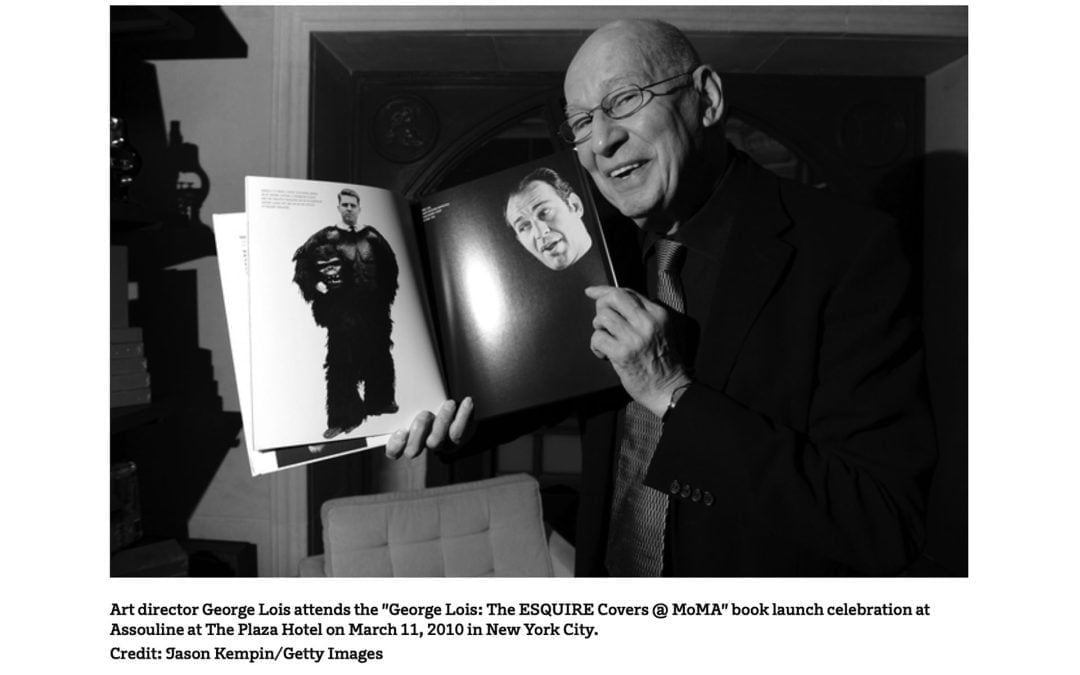The ad industry is remembering the life of George Lois, the New York advertising legend behind iconic Esquire covers, seminal ads over the 20th century and the slogan “I Want My MTV.” Lois died at the age of 91 on Friday.
Lois gained fame and won major awards with his work for agencies including Doyle Dane Bernbach, Papert Koenig Lois and Lois Holland Callaway. He also became the youngest inductee into the Art Directors Hall of Fame.
His career spanned an astonishing 60 years in the advertising industry. He began his career at Sudler & Hennessy in New York in 1956 before joining Doyle Dane Bernbach (now DDB) in its early days.
“George was giant in our industry,” Mat Bisher, chief creative officer at DDB New York, told Ad Age. “His commitment to the big idea was revolutionary; he had an unwavering passion for what he believed. It was a stake in the ground for creativity as a force in advertising and culture.”
And Rick Brim, chief creative officer at Adam&Eve/DDB, added: “There are two types of exceptional creatives. The ones who create ground-breaking trends again and again, and the ones who create work so timeless that it feels as fresh today as it did 40 years ago and will remain so for the next 40 year’s time. George Lois is most definitely the latter. His work has way outlasted many of its subject matters, from his iconic Esquire magazine covers to the “I want my MTV” campaign. All of his work is still effortless, it’s still cool and still makes me really jealous.”
Early in his career, Lois was particularly well-known for his bold, clean images in work for Wolfschmidt vodka, Xerox, Allerest, Maypo, Wheatena and Edwards & Hanly.

Long before celebrities were ubiquitous in advertising, in the 1960s Lois persuaded icons of the art world, including Andy Warhol and Salvador Dali, to feature in a series of memorable commercials for Braniff Airlines, pairing them with unexpected seatmates such as boxer Sonny Liston and baseball pitcher Whitey Ford. The tagline was “When you got it, flaunt it!”
His Esquire covers became part of MOMA’s permanent exhibition in 2008. They included Warhol drowning in a can of Campbell’s Tomato Soup, depicting the decline of pop art, and Muhammad Ali portrayed as the martyr Saint Sebastian. They also touched on provocative subjects like racism and religion. One cover depicted Black boxer Sonny Liston in a Santa hat; Time Magazine said: “George Lois’ Esquire cover depicting Sonny Liston as America’s first Black Santa…is one of the greatest social statements of the plastic arts since Picasso’s Guernica.”

Almost 30 years later, he was responsible for helping create iconic 80s brands like MTV and Tommy Hilfiger. After fledgling music video channel MTV in the 1980s failed to take off early on, he was behind a series of commercials featuring the likes of Mick Jagger and Bryan Ferry telling viewers: “If you don’t get MTV where you live, call your cable operator and say: “I want my MTV.”
The 80s also saw Lois co-direct Bob Dylan’s video for “Jokerman.” It was the only video he ever directed but it won the MTV Best Music Video of the Year Award in 1983.

Lois went on to create iconic campaigns for the likes of ESPN in the 90s, and he was still working in 2016 at the age of 84, when he launched his own New York-based agency, Lois TransMedia, Big Idea Advertising and Public Relations.
Sometimes cited as one of the inspirations for “Mad Men”’s Don Draper, Lois intensely disliked the comparison. He described the show, in his book “Damn Good Advice,” as “nothing more than a soap opera set in a glamorous office where stylish fools hump their appreciative, coiffured secretaries, suck up martinis, and smoke themselves to death as they produce dumb, lifeless advertising.”

As for his legacy, another modern-day New York creative provocateur, Greg Hahn, chief creative officer and founder of Mischief USA, described him as “an outspoken champion of bold creative work.”
“He detested the middle ground,” said Hahn. “Work like George’s, that creates talk, builds brands, and lasts decades, isn’t born in the middle ground. I once heard a quote from him, ‘You can be cautious or you can be creative, but there is no such thing as a cautious creative.’ Every act of creativity is a leap of faith, and George wasn’t afraid to take wild leaps. “
And according to David Kolbusz, chief creative officer at Orchard, what sets Lois apart from so many of his contemporaries was “The timelessness of his product.”
“It demands no historical context to be enjoyed, and it’s never celebrated for nostalgic reasons. Be it his Esquire covers, his logo work, or his ad campaigns, the design and art direction transcends the era in which they were created. Asked, “If I had to do it over again now in the present, would I do it the same way?”, the answer with Lois’ work is almost always “Good golly, yes.”
Below, more members of the ad community pay tribute to Lois, via LinkedIn.
Nancy R Tag, BIC Program Director at CCNY: “He was a towering figure, not just in the industry, but in our culture. He was a fighter >> against injustice, mediocrity, and bigotry. His swagger could mask a vast and tender generosity. His ego was big, but his heart significantly bigger.”
Rob Schwartz, chair of TBWA/New York: “You can’t be in advertising and not pay a debt of gratitude to George Lois.”
Wayne Deakin, global principal creative at Wolf Ollins: “One of my heroes.”
Marc Nohr, chairman of Fold7: “I grew up on George Lois stories, pored over his magazine front covers, and always preferred his definition of creativity over others: “The creative act, the defeat of habit by originality, overcomes everything.”
Graham Fink, founder of Fink Different: “George was one of the reasons I started my career in advertising. His book The Art Of Advertising was like a bible on my desk.”
Patrick O’Neill, freelance chief creative officer: “This man inspired so many to think bigger, act courageously and speak the unvarnished truth.
In this article:

Alexandra Jardine is Executive Editor, Creativity / U.K. Editor at Ad Age. Based in London, she has written for Ad Age since 2011 prior to which she worked on U.K. marketing and advertising titles for more than a decade, including as news editor for Haymarket weekly title “Marketing” and freelancer for Campaign, Media Week and The Guardian.

